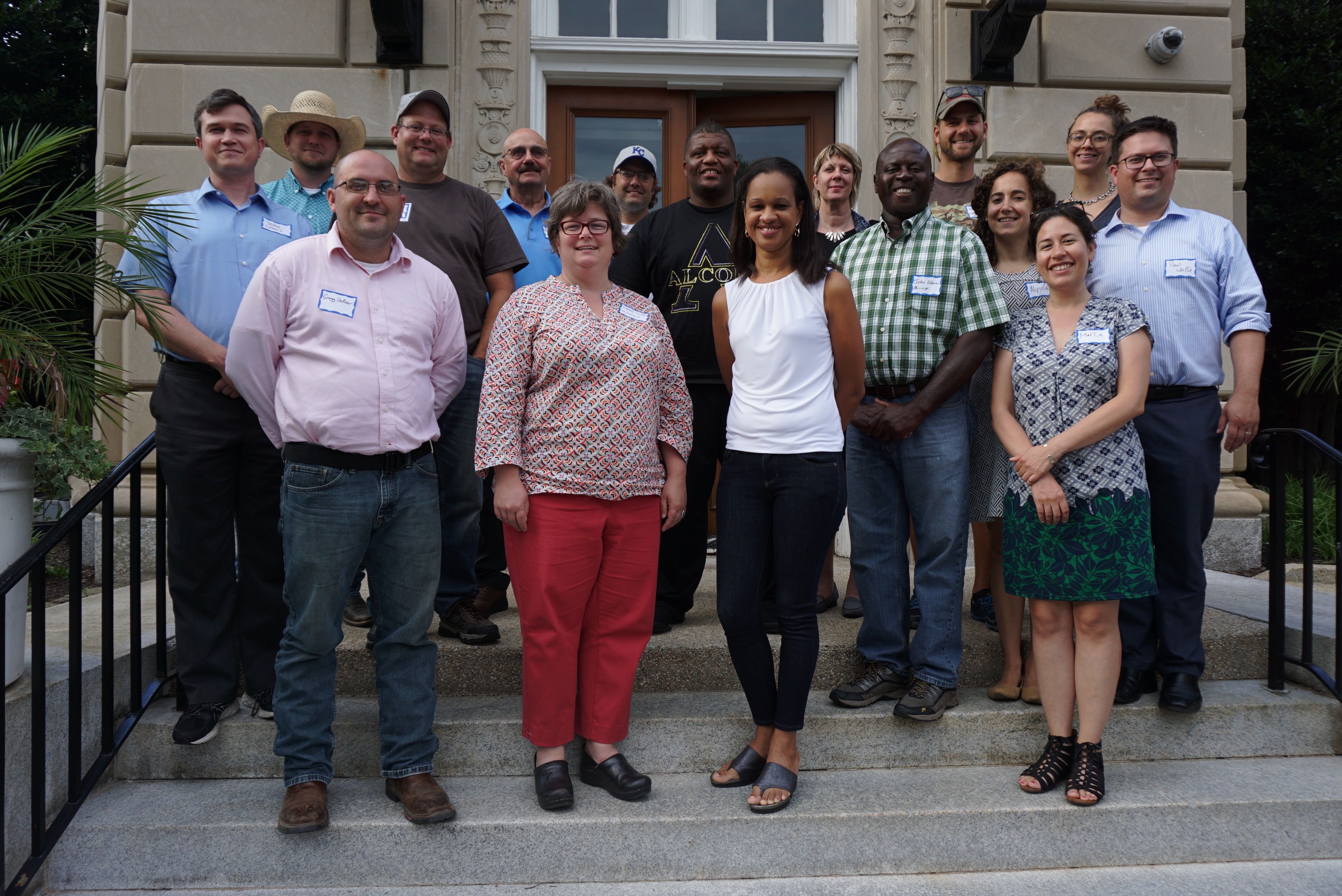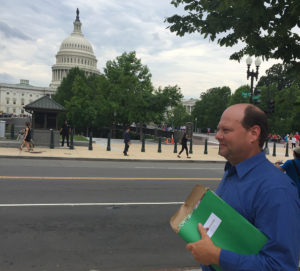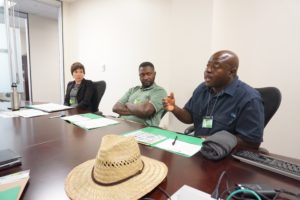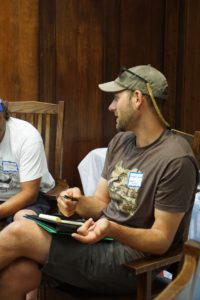
Mid-June in Washington, DC is a time when the annual appropriations cycle is in full swing, and congressional appropriators in both the House and the Senate work to set funding levels for the coming fiscal year. As part of our work to amplify farmer and rural advocate voices, the National Sustainable Agriculture Coalition (NSAC) hosts annual “farmer fly-ins.” During these fly-ins, NSAC and our members help farmers across the country to connect directly with policymakers on Capitol Hill so that they can share their priorities and describe in person how decisions made in DC affect them and their communities.
Last week, NSAC hosted its second farmer fly-in for fiscal year (FY) 2018, (click here for more information on the first), and we were fortunate to have 12 farmers and organizational representatives from 9 different states come to DC. Producers and representatives from Oregon, Mississippi, North Dakota, Wisconsin, Alabama, Georgia, Florida, Kansas, and Iowa all took time out of their busy schedules to meet with their congressional representatives, as well as with representatives from the US Department of Agriculture (USDA), and the White House Office of Management and Budget (OMB).
Given the impact of the President’s FY 2018 budget request, which called for a 21 percent ($4.7 billion) cut to USDA’s FY 2018 discretionary funding, connecting appropriators directly with the farmers and constituents who rely on USDA programs is more critical now than ever.
Working Lands Conservation
“There is an old quote that has always resonated strongly with me – ‘We are only renting the land from our grandchildren,’” said David Rosmann, an organic farmer from Iowa who attended last week’s fly-in to talk about both the importance of sustainable agriculture research and the benefits of USDA’s voluntary conservation programs.
Funding for these on-farm conservation programs, including the Conservation Stewardship Program (CSP), and the Environmental Quality Incentives Program (EQIP), provide farmers and ranchers with tools, training and financial support they need to conserve water, build soil health, and ensure their farms are vibrant and sustainable for generations to come.

“Because of CSP, what were previously my fallow acres are now full of cover crops that are busy building and strengthening my soil 24/7,” said Kansas grain farmer Brice Custer. “It was a huge deal when I was finally accepted into CSP in 2012, there was no way that we could have converted 100 percent of the farm to cover crop without that support.”
Despite the fact that demand for these programs far exceeds available funding, for the past several years congressional appropriators have frequently used a backdoor process called “Changes in Mandatory Spending” or “CHIMPS” to raid and reduce their mandatory farm bill funding allocations.
NSAC opposes any CHIMPS to mandatory funding for CSP and EQIP in FY 2018. We were very pleased to see that the recently released appropriations bill from the House Agriculture Appropriations Subcommittee did not include any cuts to mandatory funding for these vital programs.
Rural Development and Support for Underserved Farmers
“It’s hard to get up and go cut a wheat crop that you know you’re going to lose money on,” said Brice. “Input costs are so high, farmers are going broke.”
It is no secret that being a farmer is a tough job, and with the rural economy in a prolonged downturn, things are especially challenging right now for our nation’s food and fiber producers. USDA’s Outreach and Assistance to Socially Disadvantaged and Veteran Farmers and Ranchers Program (also know as the “Section 2501” program) and Value Added Producer Grant Program (VAPG) are two great options for farmers who need additional support to build or sustain their businesses.

“2501 has assisted farmers like us who sell at wholesale markets, by giving us tools and resources to be [Good Agricultural Practices] GAP certified and more market ready,” said Eric Simpson, an organic farmer who is part of the West Georgia Farmers Cooperative. “If not for them we probably never would have made progress on getting GAP certified and wouldn’t have had access to those markets.”
The 2501 Program works to level the playing field for farmers of color and military veteran farmers, who have historically been underserved by USDA and other federal programs, by arming them with the tools they need to thrive and compete in today’s agricultural economy. For decades, 2501 has been the only farm bill program dedicated to addressing the specific needs of historically underserved farmers; the program provides critical resources, outreach, and technical assistance to help veteran and farmers of color start, maintain, and grow their food and farm businesses.
Despite the crucial role 2501 plays for so many of our nation’s farmers, the program’s budget was cut in half in the 2014 Farm Bill. In order for 2501 to adequately serve farmers and provide them with the resources they need to thrive, NSAC urges Congress to provide $10 in discretionary funding for the 2501 program, restoring it to pre-2014 levels. While the House bill does not cut the program, we were disappointed to see that no additional funding was provided. NSAC will continue working with our partners and members of Congress to push for much needed additional funding in FY 2018.
Another great way that farmers can increase their competitiveness and reach new markets farmers is by “adding value” to their products. For example, one way to add value might be to take a raw agricultural product like apples and transform them into a branded applesauce. These value-added products not only help farmers improve their bottom lines because they can sell for a higher price; the processing of the product also means more jobs and support for the local community.
The VAPG program provides competitively awarded grants to individual independent agricultural producers, groups of independent producers, producer-controlled entities, organizations representing agricultural producers, and farmer or rancher cooperatives to create or develop value-added producer-owned businesses. These grants may be used to fund business and marketing plans and feasibility studies or to acquire working capital to operate a value-added business venture or alliance.
“Since its start in 2012, the Wisconsin food-hub has gone from $0 to $2 million in sales,” said Sarah Lloyd Director of Development of the Wisconsin Food Hub Cooperative. “We received two VAPG grants over the years, and those have been essential to lifting the business off the ground. Thanks to the support from those grants we were able to grow the co-op from the 11 initial farmers to now 40 farmer members.”
Agricultural Research
Research touches every aspect of a successful farming business, whether it’s a fifth generation commodity producer looking for ways to enrich her soil, or a beginning farmer interested in entering the organic seed market. The Sustainable Agriculture Research and Education (SARE) program helps formalize and provide funding for farmer-driven research and also helps publicize the results to other farmers. SARE has been funding sustainable agriculture research for 30 years, and is the only USDA competitive grants research program that focuses solely on sustainable agriculture.

“The SARE grant has brought together the community on field walks to help educate, spread the knowledge of saving seed, and has helped highlight the professional seed producers in our region who have been working diligently to produce bio-regionally adapted seed,” said Andrew Schwarz a small-scale organic farmer who is part of the Southern Oregon Seed Grower’s Association. “Open pollinated seeds are important because they allow for people to save their own seed, and they allow them to see the magic of saving seed, growing their own food, and continuing to build the diversity of our seed stocks.”
Due to high demand and insufficient funds, USDA has only been able to fund around seven percent of eligible SARE pre-proposals in recent years. Despite clear demand for the program, the president’s budget proposal would cut the program by 30 percent. Unfortunately, the House’s appropriations bill also makes significant cuts to key agricultural research programs, including a cut of $2.3 million (9 percent) to SARE. Despite SARE’s popularity and administrative efficiency, it still is not funded at even half of its authorized amount. NSAC urges Congress to fund SARE at $30 million in FY 2018, which would bring funding up to half of its authorized level.
Food Safety Training
In 2010, Congress passed the Food Safety Modernization Act (FSMA) – the first major overhaul to our nation’s food safety laws since the 1930s. Congress then created a competitive grants program in FSMA to fund training for farmer and food processors. This training, the Food Safety Outreach, Education, Training, and Technical Assistance (FSOP), is essential to bringing the approximately 180,000 farmers impacted by FSMA up to speed with the new food safety regulations.
“I work with all different levels of producers, from the smallest to the largest,” said Processing and Handling Certification Manager Suzette Edwards, who works with Quality Certification Services and Florida Organic Growers. “A lot of people are not prepared to implement the new regulations. Organic producers have a bit of an advantage because they are already used to keeping records, but the trainings are very much needed.”
FSOP is currently funded at $5 million, meaning that it can only reach a small proportion of the producers, processors, and wholesalers that are impacted by the new regulations. NSAC urges Congress to provide $10 million for FSOP in FY 2018 to ensure that farmers in all parts of the country have the training they need to comply with the new food safety requirements. Both the President’s proposed budget and the House’s budget left FSOP funding flat, at $5 million, in FY 2018.
Where Do We Go From Here?
The next step in the FY 2018 appropriations process is for the House Subcommittee’s bill to head to the full House Appropriations Committee. This will be an opportunity for NSAC and other advocates to secure any funding increases not included in the Subcommittee bill, and to fight against any harmful cuts. NSAC and our members will be actively watching as this process moves forward and working with our champions in Congress to create the best possible bill for our nation’s farmers and ranchers. Full committee markup is expected as early as the week of July 10th, but could possibly occur later.
We also expect that the Senate Agriculture Appropriations Subcommittee will begin its work on its own version of a bill in the coming weeks.

